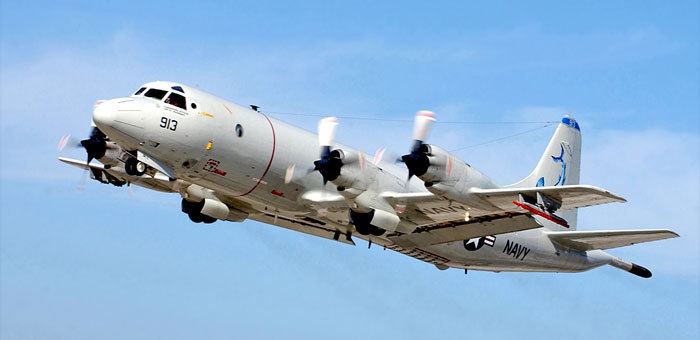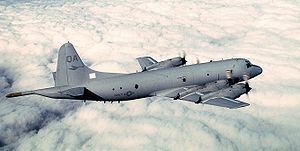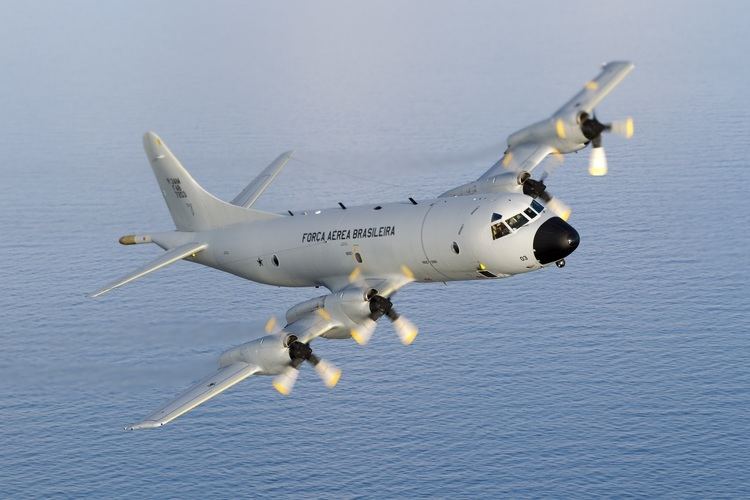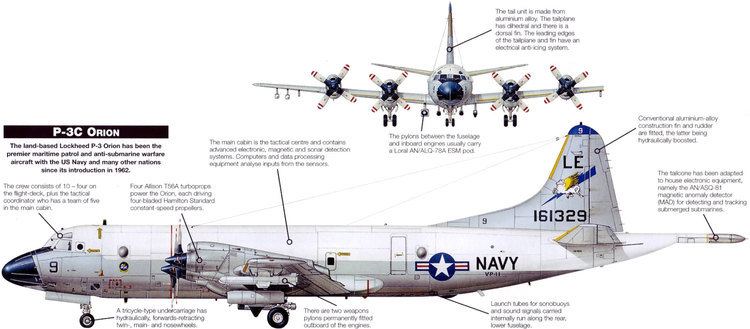Length 36 m | Wingspan 30 m Cruise speed 750 km/h | |
 | ||
Unit cost 45,000,000–45,000,000 USD (2013) Manufacturers Similar Lockheed L 188 Electra, Lockheed AP 3C Orion, Lockheed CP 140 Aurora | ||
Lockheed p 3 orion training mission pt 1
The Lockheed P-3 Orion is a four-engine turboprop anti-submarine and maritime surveillance aircraft developed for the United States Navy and introduced in the 1960s. Lockheed based it on the L-188 Electra commercial airliner. The aircraft is easily distinguished from the Electra by its distinctive tail stinger or "MAD Boom", used for the magnetic detection of submarines.
Contents
- Lockheed p 3 orion training mission pt 1
- The lockheed p 3 orion
- Origins
- Further developments
- Design
- Crew complement
- Engine loiter shutdown
- United States
- In Cuba
- In Vietnam
- In Iraq
- In Afghanistan
- In Libya
- Iran
- Pakistan
- In Somalia
- Civilian uses
- Variants
- Military operators
- Former
- Notable events accidents and incidents
- Specifications P 3C Orion
- References

Over the years, the aircraft has seen numerous design advancements, most notably to its electronics packages. The P-3 Orion is still in use by numerous navies and air forces around the world, primarily for maritime patrol, reconnaissance, anti-surface warfare and anti-submarine warfare. A total of 734 P-3s have been built, and in 2012, it joined the handful of military aircraft including the Boeing B-52 Stratofortress, Boeing KC-135 Stratotanker, Lockheed C-130 Hercules and the Lockheed U-2 that have seen over 50 years of continuous use by the United States military. The U.S. Navy's remaining P-3C aircraft will eventually be replaced by the P-8A Poseidon.
The lockheed p 3 orion
Origins

In August 1957, the U.S. Navy called for replacement proposals for the piston engined Lockheed P2V Neptune (later redesignated P-2) and Martin P5M Marlin (later redesignated P-5) with a more advanced aircraft to conduct maritime patrol and anti-submarine warfare. Modifying an existing aircraft was expected to save on cost and allow rapid introduction into the fleet. Lockheed suggested a military version of their L-188 Electra, which was still in development and had yet to fly. In April 1958, Lockheed won the competition and was awarded an initial research and development contract in May.

The prototype YP3V-1/YP-3A, Bureau Number (BuNo) 148276 was modified from the third Electra airframe c/n 1003. The first flight of the aircraft's aerodynamic prototype, originally designated YP3V-1, was on 19 August 1958. While based on the same design philosophy as the Lockheed L-188 Electra, the aircraft was structurally different. The aircraft had 7 feet (2.1 m) less fuselage forward of the wings with an opening bomb bay, and a more pointed nose radome, distinctive tail "stinger" for detection of submarines by magnetic anomaly detector, wing hardpoints, and other internal, external, and airframe production technique enhancements. The Orion has four Allison T56 turboprops which give it a top speed of 411 knots (761 km/h; 473 mph) comparable to the fastest propeller fighters, or even slow high-bypass turbofan jets such as the Fairchild Republic A-10 Thunderbolt II or the Lockheed S-3 Viking. Similar patrol aircraft include the Soviet Ilyushin Il-38, the French Breguet Atlantique and the British jet-powered Hawker Siddeley Nimrod based on the de Havilland Comet.

The first production version, designated P3V-1, was launched on 15 April 1961. Initial squadron deliveries to Patrol Squadron Eight (VP-8) and Patrol Squadron Forty Four (VP-44) at Naval Air Station Patuxent River, Maryland began in August 1962. On 18 September 1962, the U.S. military transitioned to a unified designation system for all services, with the aircraft being renamed the P-3 Orion. Paint schemes have changed from early 1960s gloss blue and white, to mid-1960s gloss white and gray, to mid-1990s flat finish low visibility gray with fewer and smaller markings. In the early 2000s, the scheme changed to a gloss gray finish with the original full-size color markings. Large size Bureau Numbers on the vertical stabilizer and squadron designations on the fuselage remained omitted.
Further developments
In 1963, the U.S. Navy Bureau of Weapons (BuWeps) contracted Univac Defense Systems Division of Sperry-Rand to engineer, build and test a digital computer (then in its infancy) to interface with the many sensors and newly developing display units of the P-3 Orion. Project A-NEW was the engineering system which, after several early trials, produced the engineering prototype, the CP-823/U, Univac 1830, Serial A-1, A-NEW MOD3 Computing System. The CP-823/U was delivered to the Naval Air Development Center (NADC) at Johnsville, Pennsylvania in 1965, and directly led to the production computers later equipped on the P-3C Orion.
Three civilian Electras were lost in fatal accidents between February 1959 and March 1960. Following the third crash the FAA restricted the maximum speed of Electras until the cause could be determined. After an extensive investigation, two of the crashes (in September 1959 and March 1960) were found to be caused by insufficiently strong engine mounts, unable to damp a whirling motion that could affect the outboard engines. When the oscillation was transmitted to the wings, a severe vertical vibration escalated until the wings were torn from the aircraft. The company implemented an expensive modification program, labelled the Lockheed Electra Achievement Program or LEAP, in which the engine mounts and wing structures supporting the mounts were strengthened, and some wing skins replaced with thicker material. All the surviving Electras of the 145 built at that time were modified at Lockheed's expense at the factory, the modifications taking 20 days for each aircraft. The changes were incorporated in subsequent aircraft as they were built.
Sales of airliners were limited as the technical fix did not completely erase the "jinxed" reputation, turboprop-powered aircraft were soon replaced by faster jets. In a military role where fuel efficiency was more valued than speed, the Orion has been in service over 50 years after its 1962 introduction. Although surpassed in production longevity by the Lockheed C-130 Hercules, 734 P-3s were produced through 1990. Lockheed Martin opened a new P-3 wing production line in 2008 as part of its Service Life Extension Program (ASLEP) for delivery in 2010. A complete ASLEP replaces the outer wings, center wing lower section and horizontal stabilizers with newly built parts.
In the 1990s, during a U.S. Navy attempt to identify a successor aircraft to the P-3, the improved P-7 was selected over a navalized variant of the twin turbofan-powered Boeing 757, but this program was subsequently cancelled. In a second program to procure a successor, the advanced Lockheed Martin Orion 21, another P-3 derived aircraft, lost out to the Boeing P-8 Poseidon, a Boeing 737 variant, which entered service in 2013.
Design
The P-3 has an internal bomb bay under the front fuselage which can house conventional Mark 50 torpedoes or Mark 46 torpedoes and/or special (nuclear) weapons. Additional underwing stations, or pylons, can carry other armament configurations including the AGM-84 Harpoon, AGM-84E SLAM, AGM-84H/K SLAM-ER, the AGM-65 Maverick, 127 millimetres (5.0 in) Zuni rockets, and various other sea mines, missiles, and gravity bombs. The aircraft also had the capability to carry the AGM-12 Bullpup guided missile until that weapon was withdrawn from U.S./NATO/Allied service.
The P-3 is equipped with a magnetic anomaly detector (MAD) in the extended tail. This instrument is able to detect the magnetic anomaly of a submarine in the Earth's magnetic field. The limited range of this instrument requires the aircraft to be near the submarine at low altitude. Because of this, it is primarily used for pinpointing the location of a submarine immediately prior to a torpedo or depth bomb attack. Due to the sensitivity of the detector, electromagnetic noise can interfere with it, so the detector is placed in P-3's fiberglass tail stinger (MAD boom), far from other electronics and ferrous metals on the aircraft.
Crew complement
The crew complement varies depending on the role being flown, the variant being operated, and the country that is operating the type. In U.S. Navy service, the normal crew complement was 12 until it was reduced to its current complement of 11 in the early 2000s when the in-flight ordnanceman (ORD) position was eliminated as a cost-savings measure and the ORD duties assumed by the in-flight technician (IFT). Data for U.S. Navy P-3C only.
Officers:
NOTE: NAVCOM on P-3C only; USN P-3A and P-3B series had an NFO Navigator (TACNAV) and an enlisted Airborne Radio Operator (RO)
Enlisted Aircrew:
The senior of either the PPC or TACCO will be designated as the aircraft Mission Commander (MC).
Engine loiter shutdown
Once on station, one engine is often shut down (usually the No. 1 engine – the left outer engine) to conserve fuel and extend the time aloft and/or range when at low level. It is the primary candidate for loiter shutdown because it has no generator. Eliminating the exhaust from engine 1 also improves visibility from the aft observer station on the port side of the aircraft.
On occasion, both outboard engines can be shut down, weight, weather, and fuel permitting. Long deep-water, coastal or border patrol missions can last over 10 hours and may include extra crew. The record time aloft for a P-3 is 21.5 hours, undertaken by the Royal New Zealand Air Force's No. 5 Squadron in 1972.
United States
Developed during the Cold War, the P-3's primary mission was to track Soviet Navy ballistic missile and fast attack submarines and to eliminate them in the event of full-scale war. At its height, the U.S. Navy's P-3 community consisted of twenty-four active duty "Fleet" patrol squadrons home based at air stations in the states of Florida and Hawaii as well as bases which formerly had P-3 operations in Maryland, Maine, and California. There were also thirteen Naval Reserve patrol squadrons identical to their active duty "Fleet" counterparts, said Reserve "Fleet" squadrons being based in Florida, Pennsylvania, Maryland, Michigan, Massachusetts (later relocated to Maine), Illinois, Tennessee, Louisiana, California and Washington. Two Fleet Replacement Squadrons (FRS), also called "RAG" squadrons (from the historic "Replacement Air Group" nomenclature) were located in California and Florida. The since-deactivated VP-31 in California provided P-3 training for the Pacific Fleet, while VP-30 in Florida performed the task for the Atlantic Fleet. These squadrons were also augmented by a test and evaluation squadron in Maryland, two additional test and evaluation units that were part of an air development center in Pennsylvania and a test center in California, an oceanographic development squadron in Maryland, and two active duty "special projects" units in Texas and Hawaii, the latter being slightly smaller than a typical squadron.
Reconnaissance missions in international waters led to occasions where Soviet fighters would "bump" a P-3, either operated by the U.S. Navy or other operators such as the Royal Norwegian Air Force. On 1 April 2001, a midair collision between a United States Navy EP-3E Aries II signals surveillance aircraft and a People's Liberation Army Navy J-8II jet fighter-interceptor resulted in an international dispute between the U.S. and the People's Republic of China (PRC).
More than 40 combatant and noncombatant P-3 variants have demonstrated the rugged reliability displayed by the platform flying 12-hour plus missions 200 ft (61 m) over salt water while maintaining an excellent safety record. Versions have been developed for the National Oceanic and Atmospheric Administration (NOAA) for research and hurricane hunting/hurricane wall busting, for the U.S. Customs Service (now U.S. Customs and Border Protection) for drug interdiction and aerial surveillance mission with a rotodome adapted from the Grumman E-2 Hawkeye or an AN/APG-66 radar adapted from the General Dynamics F-16 Fighting Falcon, and for NASA for research and development.
The U.S. Navy remains the largest P-3 operator, currently distributed between a single fleet replacement (i.e., "training") patrol squadron in Florida (VP-30), 12 active duty patrol squadrons distributed between bases in Florida, Washington and Hawaii, two Navy Reserve patrol squadrons in Florida and Washington, one active duty special projects patrol squadron (VPU-2) in Hawaii, and two active duty test and evaluation squadrons. One additional active duty fleet reconnaissance squadron (VQ-1) operates the EP-3 Aries signals intelligence (SIGINT) variant at Naval Air Station Whidbey Island, Washington.
In January 2011, the U.S. Navy revealed that P-3s have been used to hunt down "third generation" narco subs. This is significant because as recently as July 2009, fully submersible submarines have been used in smuggling operations.
In Cuba
In October 1962, P-3A aircraft flew several blockade patrols in the vicinity of Cuba. Having just recently joined the operational Fleet earlier that year, this was the first employment of the P-3 in a real world "near conflict" situation.
In Vietnam
Beginning in 1964, forward deployed P-3 aircraft began flying a variety of missions under Operation Market Time from bases in the Philippines and Vietnam. The primary focus of these coastal patrols was to stem the supply of materials to the Viet Cong by sea, although several of these missions also became overland "feet dry" sorties. During one such mission, a small caliber artillery shell passed through a P-3 without rendering it mission incapable. The only confirmed combat loss of a P-3 also occurred during Operation Market Time. In April 1968, a U.S. Navy P-3B of VP-26 was downed by anti-aircraft fire in the Gulf of Thailand with the loss of the entire crew. Two months earlier, in February 1968, another one of VP-26's P-3B aircraft was operating in the same vicinity when it crashed with the loss of the entire crew. Originally attributed to an aircraft mishap at low altitude, later conjecture is that this aircraft may have also fallen victim to AAA fire from the same source as the April incident.
In Iraq
On 2 August 1990, Iraq invaded Kuwait and was poised to strike Saudi Arabia. Within 48 hours of the initial invasion, U.S. Navy P-3C aircraft were among the first American forces to arrive in the area. One was a modified platform with a prototype system known as "Outlaw Hunter". Undergoing trials in the Pacific after being developed by the Navy’s Space & Naval Warfare Systems Command (SPAWAR), "Outlaw Hunter" was testing a specialized over-the-horizon targeting (OTH-T) system package when it responded. Within hours of the start of the coalition air campaign, "Outlaw Hunter" detected a large number of Iraqi patrol boats and naval vessels attempting to move from Basra and Umm Qasr to Iranian waters. "Outlaw Hunter" vectored in strike elements which attacked the flotilla near Bubiyan Island destroying 11 vessels and damaging scores more. During Desert Shield, a P-3 using infrared imaging detected a ship with Iraqi markings beneath freshly-painted bogus Egyptian markings trying to avoid detection. Several days before the 7 January 1991 commencement of Operation Desert Storm, a P-3C equipped with an APS-137 Inverse Synthetic Aperture Radar (ISAR) conducted coastal surveillance along Iraq and Kuwait to provide pre-strike reconnaissance on enemy military installations. A total of 55 of the 108 Iraqi vessels destroyed during the conflict were targeted by P-3C aircraft.
The P-3 Orion's mission expanded in the late 1990s and early 2000s to include battlespace surveillance both at sea and over land. The long range and long loiter time of the P-3 Orion have proved to be an invaluable asset during Operation Iraqi Freedom and Operation Enduring Freedom. It can instantaneously provide information about the battlespace it can see to ground troops, particularly the U.S. Marines.
In Afghanistan
Although the P-3 is a Maritime patrol aircraft, armament and sensor upgrades in the Anti-surface Warfare Improvement Program (AIP) have made it suitable for sustained combat air support over land. Since the start of the current war in Afghanistan, U.S. Navy P-3 aircraft have been operating from Kandahar in that role. Royal Australian Air Force AP-3C Orions operated out of Minhad Air Base in the UAE from 2003 until their withdrawal in November 2012. During the period 2008–2012, the AP-3C Orions conducted overland intelligence, surveillance and reconnaissance tasks in support of coalition troops throughout Afghanistan.
Recently, the United States Geological Survey used the Orion to survey parts of southern and eastern Afghanistan for lithium, copper, and other mineral deposits.
In Libya
Several U.S. Navy P-3C Orions, and two Canadian CP-140 Auroras, a variant of the Orion, have participated in maritime surveillance missions over Libyan waters in the framework of enforcement of the 2011 no-fly zone over Libya.
A U.S. Navy P-3C Orion supporting Operation Odyssey Dawn engaged the Libyan coast guard vessel Vittoria on 28 March 2011 after the vessel and two smaller craft fired on merchant ships in the port of Misrata, Libya. The Orion fired AGM-65 Maverick missiles on Vittoria, which was subsequently beached.
Iran
Lockheed produced the P-3F variant of the P-3 Orion, for Iran. Six examples were delivered to the former Imperial Iranian Air Force (IIAF) in 1975 and 1976.
Following the Iranian Revolution in 1979, the Orions continued in service, after the IIAF was renamed the Islamic Republic of Iran Air Force (IRIAF). They were used in the Tanker War phase of the Iran–Iraq War and were operated by one of the most successful squadrons of the IRIAF during that conflict. A total of four P-3Fs remain in service.
Pakistan
Three P-3C Orions, delivered to the Pakistan Navy in 1996 and 1997 were operated extensively during the Kargil conflict. After the crash of one, the type was grounded due to the loss of an entire crew; nonetheless, the aircraft were maintained in an armed state and airworthy condition throughout the escalation period of 2001 and 2002. In 2007, they were used by the navy to conduct signals intelligence, airborne and bombing operations in a Swat offensive and Operation Rah-e-Nijat. Precision and strategic bombing missions were carried out by the Orions, and in 2007, intelligence management operations were conducted against Taliban and al-Qaeda operatives.
On 22 May 2011, two out of the four Pakistani P-3Cs were destroyed in an attack on PNS Mehran, a Pakistani Naval station in Karachi. The Pakistani fleet had been readily used in overland, counter-insurgency operations. In June 2011, the U.S. agreed to replace the destroyed aircraft with two new ones, with delivery to follow later. In February 2012, the U.S. delivered two, additional P-3C Orion aircraft to the Pakistan Navy.
In Somalia
The Spanish Air Force deployed P-3s to assist the international effort against piracy in Somalia. On 29 October 2008, a Spanish P-3 aircraft patrolling the coast of Somalia reacted to a distress call from an oil tanker in the Gulf of Aden. To deter the pirates, the aircraft flew over the pirates three times as they attempted to board the tanker, dropping a smoke bomb on each pass. After the third pass, the attacking pirate boats broke off their attack. Later, on 29 March 2009, the same P-3 pursued the assailants of the German Navy tanker Spessart (A1442), resulting in the capture of the pirates.
In April 2011, the Portuguese Air Force also contributed to Operation Ocean Shield by sending a P-3C which had early success when on its fifth mission detected a pirate whaler with two attack skiffs.
Since 2009 the Japan Maritime Self-Defense Force has deployed P-3s to Djibouti for anti-piracy patrols, from 2011 from its own base.
Civilian uses
Several P-3 aircraft have been N-registered and are operated by civilian agencies. The US Customs and Border Protection has a number of P-3A and P-3B aircraft that are used for aircraft intercept and maritime patrol. NOAA operates two WP-3D variants specially modified for hurricane research. One P-3B, N426NA, is used by National Aeronautics and Space Administration (NASA) as an Earth science research platform, primarily for the NASA Science Mission Directorate's Airborne Science Program. It is based at Goddard Space Flight Center's Wallops Flight Facility, Virginia.
Aero Union, Inc. operated eight ex-USN P-3A aircraft configured as air tankers, which were leased to the U.S. Forest Service, the California Department of Forestry and Fire Protection and other agencies for firefighting use. Several of these aircraft were involved in the U.S. Forest Service airtanker scandal but have not been involved in any catastrophic aircraft mishaps. Aero Union has since gone bankrupt, and their P-3s have been put up for auction.
Variants
Over the years, numerous variants of the P-3 have been created. A few notable examples are:
Military operators
In 2002, the RAAF received significantly upgraded AP-3C. Also known as Australian Orions they are fitted with a variety of sensors. They include digital multi-mode radar, electronic support measures, electro-optics detectors (infra-red and visual), magnetic anomaly detectors, identification friend or foe systems, and acoustic detectors. The Boeing P-8 Poseidon is gradually replacing them.
Former
United States
Notable events, accidents, and incidents
Specifications (P-3C Orion)
General characteristics
Performance
Armament
Avionics
